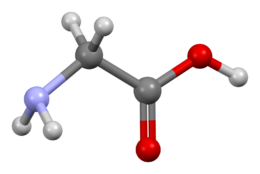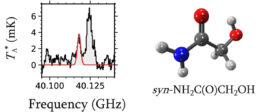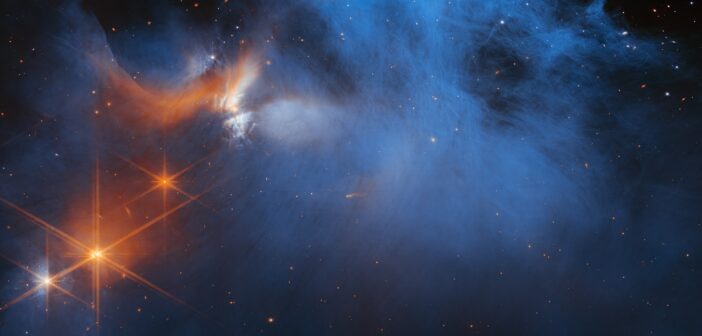Astronomers have made the first detection of interstellar glycolamide, a molecule closely related to the simplest of the amino acids necessary for life on Earth. Glycolamide is the latest interstellar molecule detected in the G+0.693–0.027 molecular cloud near the center of the Milky Way.
An Elusive Acid

A model of a glycine molecule. Carbon atoms are shown as dark gray, hydrogen atoms are light gray, oxygen atoms are red, and nitrogen is blue. [Ben Mills; Public Domain]
The simplest of the amino acids necessary for life on Earth is glycine, which contains just 10 atoms. Glycine has been detected in various places in our solar system, but we’ve yet to detect it definitively in the interstellar medium. In a recent article, a research team led by Víctor Rivilla (National Institute of Aerospace Technology–Spanish National Research Council) took the search for interstellar glycine in a new direction by widening the investigation to include its chemical cousins.
Isolating an Isomer
A glycine molecule contains two carbon atoms, two oxygen atoms, five hydrogen atoms, and one nitrogen atom. But there’s more than one way to arrange these atoms into a molecule, and glycine has many isomers: molecules with the same atoms but arranged in a different way. To search for glycine and its isomers, Rivilla and collaborators turned radio telescopes toward G+0.693–0.027, an interstellar molecular cloud near the center of the Milky Way that is already known to host a number of complex organic molecules.

Left: Example of an emission line from glycolamide detected in this work. Right: The structure of the glycolamide molecule. The molecule is similar to glycine except the carbon atom that is doubly bonded to an oxygen atom is adjacent to the nitrogen atom. [Adapted from Rivilla et al. 2023]
Tracing Chemical Pathways
Rivilla and collaborators used the measured abundances to explore the likeliest ways glycolamide is created in the interstellar medium. These molecules likely form on the surface of dust grains, where atoms and molecules can gather and link up in the sparse environment of a molecular cloud. For the case of G+0.693–0.027 specifically, ultraviolet photons might create an abundance of highly reactive molecules called radicals, which could interact in this environment to form glycolamide.

Pathway proposed in this work to form glycolamide (NH2C(O)CH2OH) in the interstellar medium. Click to enlarge. [Rivilla et al. 2023]
Citation
“First Glycine Isomer Detected in the Interstellar Medium: Glycolamide (NH2C(O)CH2OH),” Víctor M. Rivilla et al 2023 ApJL 953 L20. doi:10.3847/2041-8213/ace977
